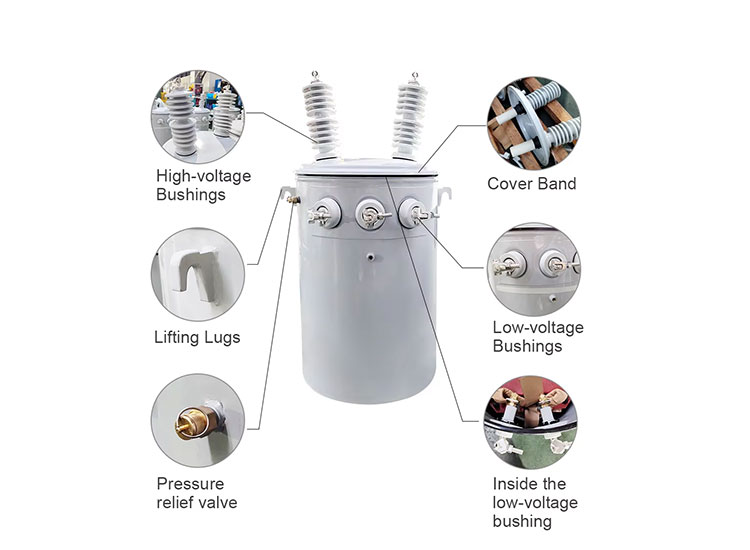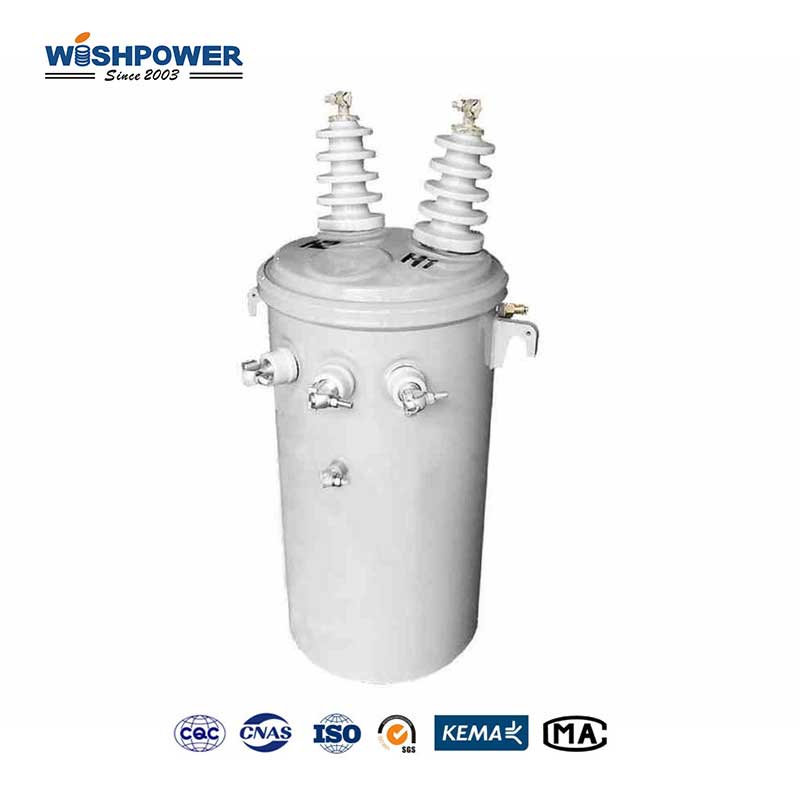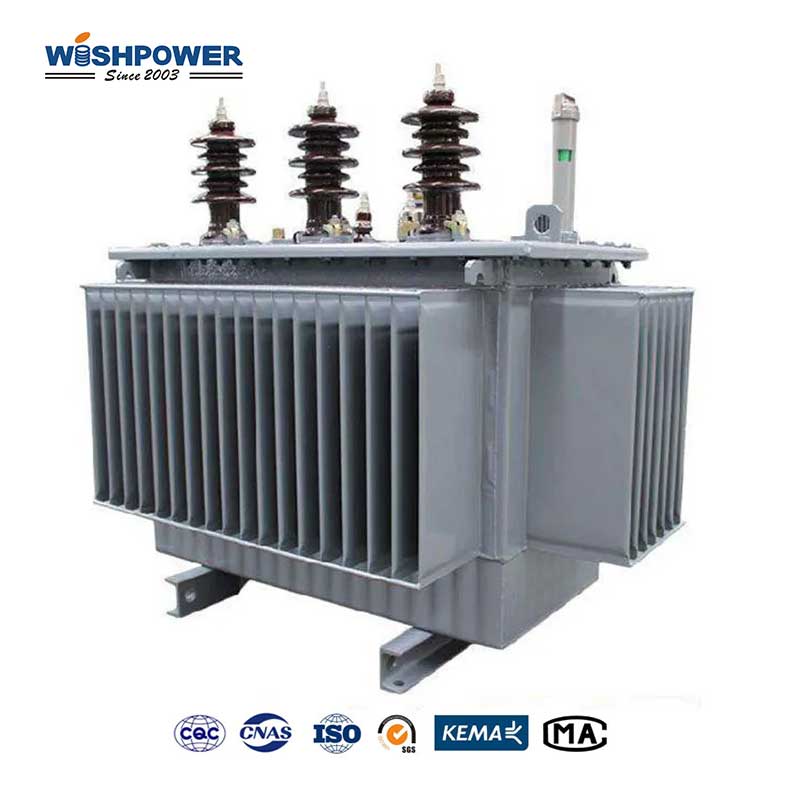In rural, agricultural, and low-demand electricity usage areas such as residential areas, a single-phase pole-mounted transformer is an important component of an electrical power distribution system. So these transformers are mounted on poles to supply power to individual homes, small businesses, and farms in the most efficient possible sense.

What are the specifications of a single-phase pole-mounted transformer?
- Voltage Ratings
The voltage rating of a single-phase pole-mounted transformer is one of the most critical specifications. Voltage ratings tell us how much voltage the transformer can step up and how much it can step down.
Primary Voltage: Generally, from 2.4 kV to 35 kV, corresponding to the power supply line.
Secondary Voltage: It usually runs from 120 V to 240 V to accommodate residential or small commercial customers’ requirements.
The purpose of these voltage levels is to provide a smooth predictable supply of electricity to end users.
- Power Rating (kVA Capacity)
The transformer capacity is determined by the power rating (kVA) that the transformer can carry. There are various ratings of pole-mounted single-phase transformers so that the diversified energy demands can be catered to. Common ratings include:
5 kVA
10 kVA
15 kVA
25 kVA
50 kVA
A match in the consumer’s energy needs with the kVA capacity will ensure efficiency and prevent the consumer from being overloaded.
- Frequency
Single-phase pole-mounted transformers operate at standard power frequencies:
Regions like Europe, Asia, Africa at 50 Hz
North America, certain regions of South America, and elsewhere are all 60 Hz.
This matching with the local power grid is necessary to prevent operational inefficiencies.
- Insulation Class
The insulation class is an indication of how high a temperature the transformer insulation will withstand without creating a degradation in its performance. Common insulation classes for single-phase pole-mounted transformers include:
Class A: 105°C
Class B: 130°C
Class F: 155°C
Class H: 180°C
Higher insulation class adds to the durability and lifespan of the transformer especially in varying load conditions.
- Efficiency Levels
The transformers are engineered to minimize energy loss while operating. Single-phase pole-mounted transformers have great efficiency of 97% to 99% on full load. This efficiency reduces energy waste and lowers the operational costs for users.
- Core Material
The efficiency and energy loss of the transformer essentially depend on its core material. Single-phase pole-mounted transformers often feature cores made of:
Silicon Steel Laminations: For minimum hysteresis and eddy current losses.
Amorphous Steel: To reduce losses at no load and increase efficiency.
The choice of high-quality core materials ensures the best performance and energy conservation.
- Cooling Method
Transformer cooling methods are required to control operating temperature. Single-phase pole-mounted transformers typically utilize the following cooling types:
ONAN (Oil Natural Air Natural): The cooling medium used by the transformer in case of heat dissipation is mineral oil or synthetic oil. Further cooling of the oil is further assisted by natural airflow.
The oil insulates internal components and also provides flood protection.
- Tank Design and Material
The internal components are housed within the transformer tank which protects internal components from external environmental factors.
Material: Durable and corrosion-resistant steel often
Source:
Also made of durable, corrosion-resistant steel
Sealing: Hermetically sealed tanks guarantee zero moisture ingress, extending the operational, life of the transformer.
External fins or radiators are added to pole-mounted transformers for improved heat dissipation.
- Weight and Dimensions
Single-phase pole-mounted transformers are dependent on the weight and dimensions of their power ratings. They are generally compact and lightweight and are easy to pole mount. For example:
It weighs approximately 150 kg to 200 kg for a 10 kVA transformer.
The weight of a 50 kVA transformer may amount to 400 kg to 500 kg.
Installations in remote areas are made simpler and cheaper by its compact design.
- Bushing and Terminals
Transformer windings are connected to the power lines using bushing and terminals. Key features include:
High-Voltage Bushings: Primary voltage connections designed.
Low-Voltage Bushings: Support secondary voltage output.
Weatherproof Terminals: They must be for durability and protection from environmental conditions.
- Protection and Safety Features
Single-phase pole-mounted transformers are integrated with safety features to ensure proper operation as well as to avoid electrical dangers. These include:
Overload Protection: Excessive current protection is provided by built-in fuses or circuit breakers for the transformer.
Surge Arresters: Protect against lightning-induced or switching operation-induced voltage spikes and surges.
Pressure Relief Valve: If it’s a fault, it releases excess pressure to prevent tank rupture.
Grounding: This prevents a fault current from dissipation in an unsafe manner.
- Environment Protection and Sustainability
The increasing design of single phase pole mounted transformers with environmental considerations.
Eco-Friendly Insulating Fluids: Switching from mineral oil with biodegradable or synthetic lubricants.
Reduced Noise Levels: They have minimal noise pollution because of low core vibration, so they’re appropriate for living areas.
Durable Coatings: Coatings that guarantee long-lifetime outdoor use are anti-corrosive.
Single-phase pole-mounted Transformers applications
Firstly, it’s important to understand specifications because as I’ve mentioned understanding specifications is so important but it’s also important to know where these transformers are found used.
Residential Power Distribution: They supply power to individual homes and a few neighborhoods.
Agricultural Power Systems: serving as energy for irrigation systems, pumps, and lighting in rural areas.
Commercial Applications: For powering small shops, offices, and businesses with low energy demands.
Remote and Off-Grid Power Supply: Feasible with severely restricted access to three-phase power systems.
Conclusion
Single-phase pole-mounted transformers are an efficient, cost-effective, and reliable solution to power distribution in low-load areas due to their specifications. With the help of your customers, you can understand factors like voltage rating, insulation class, core materials, and safety features to pick the right transformer tailored to your customer’s requirements. These transformers also minimize the losses during production and reduce the costs of operating, ideal for residential, agricultural, and small commercial processes.
If you have different opinions or want to know more, please leave a message on the website or contact us directly at info@wishpower.net
















